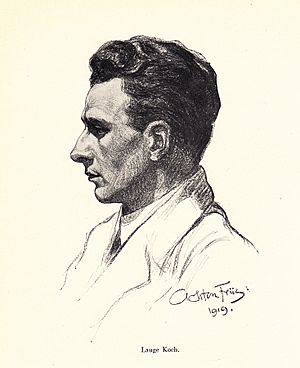Lauge Koch facts for kids
Lauge Koch (born July 5, 1892 – died June 5, 1964) was a Danish geologist and Arctic explorer. He spent many years exploring the icy lands of Greenland.
About Lauge Koch
Lauge Koch was born in 1892. His father was Karl Koch. Lauge was greatly inspired by his father's cousin, Johan Peter Koch. Johan was also a polar explorer. He went on several expeditions to Greenland. This included a trip across Greenland in 1912-1913.
Lauge Koch studied at the University of Copenhagen. He started his studies in 1911. In 1920, he earned his master's degree. Later, in 1929, he received his doctor's degree. His special study was about the layers of rock in Greenland, called "Stratigraphy of Greenland".
Expeditions and Discoveries
Lauge Koch led 24 Danish government expeditions to Greenland. He was a very important figure in Arctic exploration.
He was also part of a big discussion among scientists. This was called the Lauge Koch Controversy. It started in 1935. Some Danish geologists disagreed with his scientific methods. They reviewed his book, Geologie von Grönland (1935).
One of Koch's important trips was the Bicentenary Jubilee Expedition in 1921–23. He traveled by sledge along the north coast of Greenland. He went around Peary Land and back across the Inland Ice. On this journey, Koch found a dip in the land. He believed it was what Robert Peary had thought was a channel in 1892. This was known as the "Peary Channel". Koch's findings changed maps of Independence Fjord.
In 1922, he mapped Hiawatha Glacier. He saw that the glacier's end reached into Lake Alida. This lake is near Foulk Fjord.
In 1938, Lauge Koch made another exciting discovery. He found a large skeleton in the mountains west of Jameson Land. This area is near Scoresby Sound. The skeleton was from a huge extinct animal. It was similar to a giant animal head found earlier near the pyramid of Chephren. Koch's skeleton was later shown at a museum in Copenhagen.
Lauge Koch also helped exploration in other ways. In the mid-1930s, he set up many field stations. These were like small bases and huts for travelers. They were in Central East Greenland. This made it easier for Danish explorers to work in the Arctic.
His last expedition was the 1956-58 Expedition to East Greenland. He used helicopters on this trip. However, the Danish government stopped funding the expedition. This ended Koch's career as an expedition leader.
Legacy
A mineral called kochite was named after Lauge Koch. This mineral is found in places like Mt Hvide Ryg and Werner Bjerge. It was named to honor his explorations in these areas of Greenland.
Honours
Lauge Koch received many awards for his work.
- In 1924, he became an Honorary Fellow of the American Geographical Society.
- In 1930, he received the Daly Medal from the same society.
- He was also given the Vega medal by the Swedish Society for Anthropology and Geography.
- In 1927, he received the Patron's Medal from the British Royal Geographical Society. This was for his important work in Greenland.
- He also got the Hans Egede Medal from the Royal Danish Geographical Society.
- In 1949, he was awarded the Mary Clark Thompson Medal from the National Academy of Sciences.
See also
 In Spanish: Lauge Koch para niños
In Spanish: Lauge Koch para niños
- Cartographic expeditions to Greenland
- Three-year Expedition
- Peary Channel


